 Comments | SECTIONS: | The New World | Writing | Thoreau | Home | Comments | SECTIONS: | The New World | Writing | Thoreau | Home |  Bike Pages Bike Pages | | |
DIRECTORIES: | Lifestyle | Commuting
| Touring | Health | Advocacy |  Traffic Traffic | Skills | Humor |Survey | Links | | Skills | Humor |Survey | Links | |
|
How to Avoid Bike-Car Collisions, Illustrated
Motorist Caused Accidents
This page focuses on dangerous traffic situations which could result in collisions, injuries, and even death due to the fault of the motor vehicle operator. Another page looks at the kinds of accidents caused by cyclist error. I also have a page providing data about all the types of bicycle-motor vehicle crashes and another page discussing how to ride safely in traffic. At the bottom of this page are links to illustrated pages elsewhere. The following threatening situations all have effective solutions which the cyclist can follow. This page will provide a diagram of each type of situation, explain its characteristics and show how to avoid it.
These rules are important to cyclists at all times and would help in all the situations below:
1. Obey the traffic laws which apply to vehicles, and be part of the traffic flow.
2. Keep alert whenever other vehicles are nearby, and pay attention to their behavior.
3. Be visible. Use bright colors during the day, lights and refectors at night.
4. Take the safest route.
5. Keep the bike in good condition.
For a discussion, see How to Ride in Traffic.
These specific behaviors will help in most of the situations below:
1. Act assertively as if you belong; don't wobble along the gutter.
2. Pay attention all vehicles which are near or moving in your direction.
3. Make eye contact with motorists who may be about to turn or pull out.
4. To observe traffic behind you, glance over your shoulder (but only if you can do so without swerving!) or use a rear-view mirror.
5. Keep your hands near your brakes when traffic is nearby, and know how to brake effectively.
6. Don't be in too large a gear, so you can accelerate if necessary.
7. Know how to turn sharply in the event of an emergency.
8. Exit the roadway if all else fails. To do so, pull off and stop. Never swerve off and back on or along the road margin. Don't form the habit of diving off of the roadway whenever the situation threatens, as this instructs motorists that they can safely ignore you.
9. If you become tired from cycling or are sleepy, get off of the roadway to rest, as fatigue contributes to many accidents. Never ride after drinking alcohol.
One final and most helpful step is to study the following mistakes which motorists make and learn how to avoid them, as you will see the same mistakes repeated many times.
|
An Explanation of the Details of the Following Diagrams
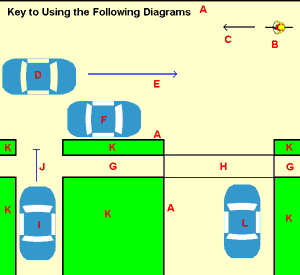 A. Curb or road edge, a thick black line.
A. Curb or road edge, a thick black line.
B. The cyclist.
C. Path cyclist will follow, in black.
D. Moving car or vehicle.
E. Path moving vehicle will follow, in blue.
F. Parked car next to curb, no arrow, hence not moving.
G. Sidewalk.
H. Crosswalk.
I. Car or other vehicle in driveway.
J. Path vehicle will follow, indicating a stop.
K. Grass, trees, waste land, buildings, whatever.
L. Car stopped at intersection; no arrow, not next to curb.
NOTE: Distances have been compressed.
NOTE: The diagrams often include just half of the street.
NOTE: Arrows indicate vehicle movement only.
NOTE: Any vehicle without an arrow is stopped.
|
The Group IB Type Collision
This kind of collision involves the motor vehicle leaving a driveway or parking space and serious injuries are unlikely. About 8.8% of all car-bike collisions are of this kind. However, over 2/3rds of the time, the cyclist was partially at fault for riding on the sidewalk or for traveling in the wrong direction.
|
|
Running into or Being Struck by a Vehicle Leaving a Driveway or Parking Lot

SITUATION: A motor vehicle is leaving an alleyway, driveway, parking lot, or parallel parking space either by traveling forward or by backing up. This can also happen while traveling through a parking lot. A cyclist can get hit by the vehicle or can run into it.
HOW TO AVOID INJURY: As you travel down a street, don't hug the curb or ride too close to parked vehicles. Pay attention to nearby occupied vehicles, whether parked or not. Have your hands on or near the brakes, and be prepared to act. Brake, accelerate, or turn to the right as necessary.
|
Group IIB and IID Type Collisions
These collisions or potential collisions involve the motorist failing to stop at an intersection (12.7% of all accidents) or making a turn which violates the cyclist's right-of-way (15.4%).
|
|
Getting Hit by a Vehicle that Fails to Yield at an Intersection
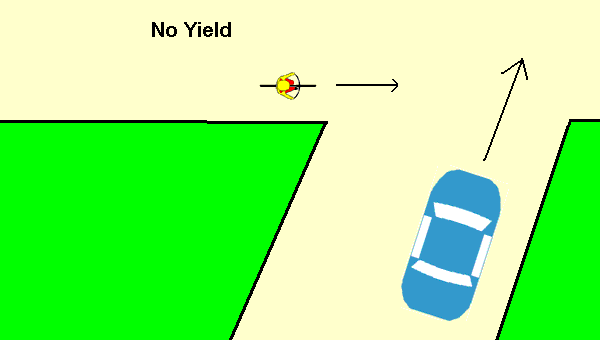
SITUATION: The cyclist has the right-of-way and is traveling towards or through an intersection. A vehicle which is supposed to yield either doesn't stop or starts while the cyclist is still in the intersection. The vehicle could be going straight or turning in either direction. The cyclist could crash into the vehicle or the vehicle could hit the cyclist.
HOW TO AVOID INJURY: Whenever you approach an intersection, pay attention to the traffic lights and do not proceed on a yellow light. Also watch any vehicles which are approaching the intersection or are stopped on your left or right. Keep your hands on or near your brakes. Maintain a good speed and stay in the through lane (not the turn lane). If a vehicle fails to yield, your exact behavior will depend on its position and direction of travel, but the three ways to avoid a collision involve accelerating (for a vehicle that enters the intersection behind you), turning, and braking. If you turn to avoid a collision, be careful not to turn into another danger. Usually, the safest path will be a sharp turn to the right.
|
|
Getting Struck by a Vehicle Making a Left Turn
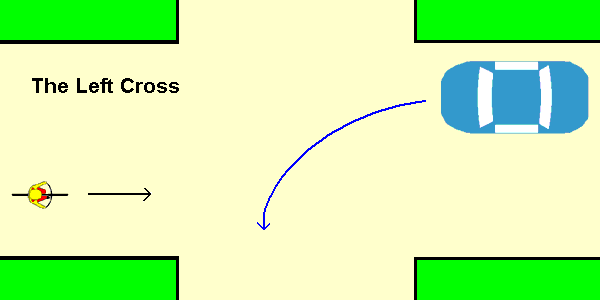
SITUATION: When the traffic light changes, and vehicles begin to cross the intersection, those which are going straight ahead have the right-of-way over those which are turning. However, some motorists tend to feel that they have the right-of-way solely because they are driving motor vehicles, and thus they will turn as if the cyclist doesn't exist. This kind of driver error also occurs sometimes when the motor vehicle is turning into a drive if the motorist doesn't notice the cyclist. In the one case when this happened to me, the motorist was blinded by the sun.
HOW TO AVOID INJURY: When you travel through an intersection, ride in the travel lane, not near the gutter and not in the right turn lane, as this may suggest that you are turning. Use a gear that allows you to accelerate if necessary. Keep your hands near your brakes. A vehicle coming towards you that is going to make a left turn will indicate that fact even if there is no hand or turn signal by traveling slowly and towards the center of the road. It may be in the left turn lane. Try to make eye contact with the operator. Braking, turning, and accelerating are ways to avoid the vehicle. In some cases, a turn to the left can avoid the vehicle but be careful not to end up in the pathway of a vehicle passing it on the right.
|
|
Getting Struck by a Vehicle Making a Right Turn
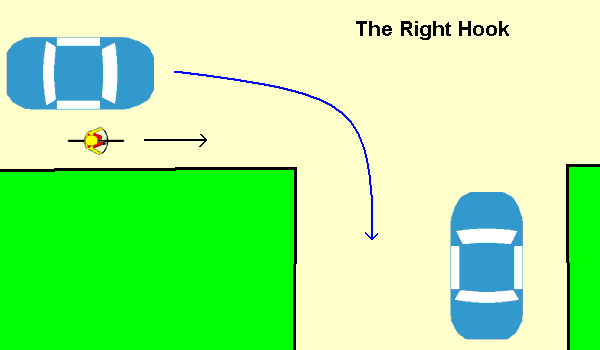
SITUATION: It's quite common for a motorist who has just passed a cyclist to immediately make a right turn. The motorist may not be paying conscious attention to the situation or may underestimate the speed of the cyclist. In a few accidents of this type, the cyclist is actually trying to pass the motorist on the inside. Although most often occuring on city streets, the right hook is also common at exit ramps, where the motorists seem to have a phobia against passing cyclists on the right.
HOW TO AVOID INJURY: Don't hug the curb (which sends the message that you are not traffic), and don't ride in the right turn lane, which suggests that you are about to turn. Keep alert and with the hands near the brakes. If a vehicle passes you, note if it seems to be heading towards the right, and brake if it starts to turn. Never pass a motor vehicle on the right at an intersection unless it is clearly turning left.
|
Group IIIB Type Collisions
These collisions or potential collisions involve the motorist passing a cyclist. They constitute 8.6% of bike-car crashes.
|
|
Getting Clipped by a Passing Motor Vehicle
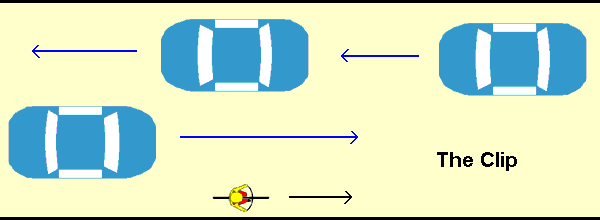
SITUATION: A motorist passing too close to a cyclist can give a glancing blow, often with the mirror. Although the traffic laws stress the need for the cyclist to keep to the right, this kind of collision is encouraged by the cyclist hugging the right edge of the road and seemingly offering the motorist an opportunity to pass where the room is inadequate.
HOW TO AVOID INJURY: Avoid riding too close to the edge of the pavement which could cause a fall. If the traffic lane is not wide, it may be necessary to ride several feet away from the pavement edge so motorists will have to pass you in the other lane. This extra space also provides a safety margin. If allowing vehicles to pass where the road is narrow, check to make sure that each vehicle has moved over sufficiently. Always give yourself enough room on the roadway to move to the right if necessary.
|
|
A Near Sideswipe Plus a Potential Secondary Collision

SITUATION: In this situation, the motorist approaching behind a cyclist either does not notice the cyclist until the last second or does not understand the necessary for moving gradually to the left. In either case, the motor vehicle violently swerves into the opposite lane just before striking the cyclist. An on-coming vehicle may be run off of the road.
HOW TO AVOID INJURY: A cyclist is unlikely to be injured in this kind of collision but other people are. Wear bright colors, be aware of visibility problems (see below), check on vehicles approaching from the rear, and be prepared to exit the roadway if necessary.
|
|
A Choice of Collisions

SITUATION: The cyclist is approaching or passing a parked car, pavement hole, or other obstacle and either swerves left, getting stuck by a passing motor vehicle, or is forced to hit the obstacle to avoid getting struck. In a few cases, hitting the obstacle results in the cyclist also getting hit by the motor vehicle.
HOW TO AVOID INJURY: The cylist should not assume that the motorist can quickly respond to a sudden swerve. Nor should the cyclist try to squeeze between the obstacle and the motor vehicle. Instead, the cyclist should move left before the motor vehicle is close even if that means slowing that vehicle. If the cyclist can not move over early, the cyclist should stop and wait until after the motor vehicle has passed before proceeding.
|
|
Getting Struck by or Impacting a Suddenly Opened Car Door

SITUATION: Cyclists, by custom and by law, ride mostly in the right-hand portion of the outside lane. This means that, on streets where automobiles and other motor vehicles are parallel parked, cyclists generally pass very close to the vehicles. However, a car door which is suddenly flung open can extend three or four feet into the traffic lane. A cyclist running into an open door can be severely injured, but even worse, the impact can throw the cyclist out in the traffic lane to be run over by another motor vehicle.
HOW TO AVOID INJURY: As general behavior, ride far enough away from parked vehicles that a flung open door can't hit you; that is, a minimum of four feet. In the event that you have to squeeze by such a vehicle, check to be sure that no one is inside; otherwise, stop to let vehicles pass before proceeding.
|
|
Getting Side-Swiped by a Vehicle Racing to Pass the Cyclist

SITUATION: A cyclist is traveling on a narrow two-lane with a motor vehicle approaching from both directions. The following vehicle should slow until there is enough space to pass, but sometimes the driver will speed up to dive into the diminishing gap between vehicles. This situation can also occur when a motorist is passing a cyclist with limited visibility due to a curve or hill. If an on-coming vehicle suddenly appears, the motorist will swerve towards the edge of the road.
HOW TO AVOID INJURY: Whenever a vehicle is passing you, have your hands and the brakes and be prepared to use them. Speed up or slow down as necessary to make passing easier. If the squeeze occurs, brake hard to avoid being side-swiped.
|
|
Running into a Vehicle that Passes and then Stops

SITUATION: A cyclist is passed by a motorist who pulls in front and suddenly slows or stops. This most frequently happens at a red light, the motorist wanting to be first when the light changes. The motorist could also be slowing to make a turn. Since automobiles can now stop faster than bicycles, the cyclist can crash into the rear of the motor vehicle.
HOW TO AVOID INJURY: Whenever someone passes you, have your hands on the brakes, and be prepared to use them. If someone is racing you to a red light or stop sign, be prepared to stop.
|
|
Getting Struck by a Vehicle Passing an On-Coming Vehicle
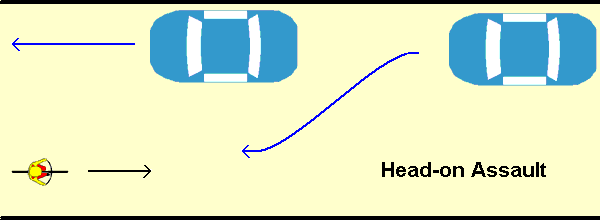
SITUATION: Most of the other potential collisions here can be classified as driver error, but this is a crime called vehicular assault, as it is illegal to pass when traffic is in the other lane. The motorist is not wanting to kill the cyclist but either to squeeze past him or to force him off of the road.
HOW TO AVOID INJURY: Riding close to the edge of the road encourages those who wish to squeeze by, so riding towards the center of the lane will avoid some incidents of this nature. Don't ride along daydreaming, but watch what is happening around you. If someone passes an on-coming vehicle, stay on the road as long as possible, as most motorists will stop if they see you are holding your position. But be prepared to exit!
|
|
The Cyclist Not Being Seen Due to a Visibility Problem

SITUATION: Some motorists drive with the assumption that nothing is on the roadway in front of them. Thus, they drive at full speed with fogged or frosted windshields, into a blinding sun or blinding headlights, in fog, heavy snow or rain, and over hills and around curves where visibility is limited. At night, they might outdrive their headlights; that is, travel over hills and dips and around curves so quickly that they can't stop in time to avoid hitting what their headlights suddenly reveal.
HOW TO AVOID INJURY: To be more visible in ordinary conditions, wear bright clothing during the day, and use lights and reflectors at night. If the motorist can't see around a right curve, riding away from the edge of the road can make you visible sooner. If you must ride when the visibility is poor, watch approaching motorists carefully. If they fail to slow or to move left to pass, be prepared to exit the roadway.
|
|
Another Vehicle Not Seen Due to a Visibility Problem

SITUATION: This problem will occur only on a hill or curve on a narrow two-lane road. The motorist can see the cyclist and moves left to pass, unaware of an approaching vehicle which the cyclist can see.
HOW TO AVOID INJURY: On hills and curves, use hand signals to tell motorists when it is safe to pass, but only do so when you can see clearly. If a vehicle is approaching, make the stop signal with your hand, waving it somewhat to get the motorist's attention. If he fails to slow, slam on the brakes or exit the roadway as necessary.
|
|
Getting Struck from the Rear on a Four-Lane due to Lane Changes

SITUATION: In some states, the four-lane highways have narrow outside lanes and no shoulders. A motorist, approaching a cyclist from the rear will slow somewhat and swap into the inside lane to pass. In a few cases, an inattentive motorist in a second vehicle following the first, but traveling on the inside lane, will suddenly swap to the outside lane to in order to pass the first motor vehicle, unaware that the cyclist is there.
HOW TO AVOID INJURY: Don't ride on narrow four-lane, high-speed roads without shoulders if they have heavy traffic. If you must travel on such a road for a short distance, exit the roadway whenever a pack of vehicles approaches.
|
As I have stated elsewhere, avoiding bike-car collisions is usually not all that difficult. However, a cyclist can not ride while daydreaming about something else while motor vehicles are nearby. Reserve daydreaming to those times when you have the road to yourself and otherwise pay active attention to approaching and nearby vehicles. Get ready for emergencies by placing your hands on the brakes. Position your bike in a safer position on the roadway if necessary. Then, if a motorist should make a stupid move, you are watching and are prepared to act. Your chances of getting injured should be small as a result.
There are four other sites on the web which also use graphic diagrams to illustrate car-bike collisions. Two are handbooks, John S. Allen's Street Smarts and Wayne Pein's Road Vogue, and two illustrate collision situations only, Michael Bluejay's How to Not Get Hit by Cars and Carol Tan's A
Crash-Type Manual for Bicyclists, the last including a statistical analysis.
|
 Comments | SECTIONS: | The New World | Writing | Thoreau | Home | Comments | SECTIONS: | The New World | Writing | Thoreau | Home |  Bike Pages Bike Pages | | |
DIRECTORIES: | Lifestyle | Commuting
| Touring | Health | Advocacy |  Traffic Traffic | Skills | Humor |Survey | Links | | Skills | Humor |Survey | Links | |
TRAFFIC ARTICLES: | Traffic | Accidents | Errors |  Collisions Collisions  | Children | Wrong | Fear | Gingerbread | Assertiveness | Obey | Rules | Riders | Motorists | Dogs | | Children | Wrong | Fear | Gingerbread | Assertiveness | Obey | Rules | Riders | Motorists | Dogs |
|













